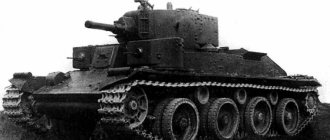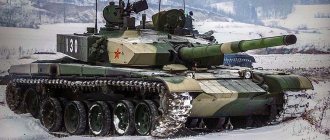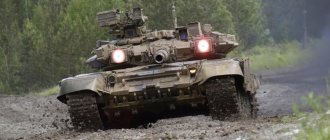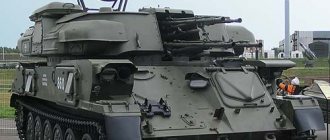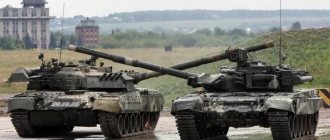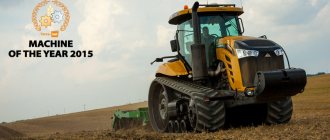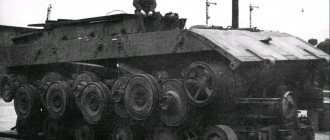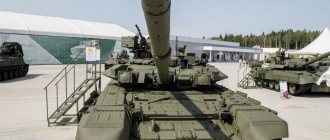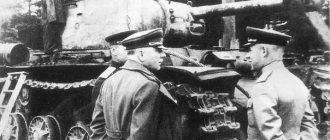Czechoslovak modernization of the T-34-85 with increased firepower and better armor.
Greetings, tankers! With you Wotpack and a guide to the Czechoslovakian tier 7 medium tank Konštrukta T-34/100 in World of Tanks. Let's look at its characteristics, where to start researching and how to play correctly. We will choose the skills and the best equipment.
TTX Konštrukta T-34/100
Unlike the Soviet T-43, the Czechoslovakian tank received a 100 mm cannon at its disposal. Therefore, the firepower is significantly superior to the Soviet modernization of the T-34-85. One-time damage is at the level of the average level 8 ST, and penetration with gold cumulative is even superior to many of its classmates. The basic armor-piercing one penetrates 175 mm, which is also pretty good.
Ammunition characteristics:
But other than that, the pronounced advantages end there. Stabilization is mediocre, and vertical guidance angles are -5...+20°. The price for penetration and alpha was low damage per minute, since reloading takes a lot of time, so it’s difficult for him to shoot anyone using DPM.
In terms of armor, it is almost a complete copy of the T-34-85, but with a slightly stronger turret and a larger gun mantlet. Due to the rational angles of the armor, ricochets are sometimes possible, but in general the armor is weak and will penetrate everything at a right angle.
armor scheme Konštrukta T-34/100
Good top speed, but low power density, so acceleration isn't fast. The visibility is not bad, but due to the size of the car, the stealth coefficient is low, so it is rare that it will spot someone first.
Armament
A preserved copy at the exhibition.
The Tiger's armament consisted of a cannon and two machine guns - a front-mounted machine gun and a turret-mounted one, coaxial with the gun. Later, mortars appeared that made it possible to create a smoke screen or hit nearby infantry with fragmentation grenades.
A gun
The main weapon of the tank is a KwK 36 L/56 rifled gun with a caliber of 88 mm. The barrel length was 56 calibers. Thanks to the hydraulic drive, the gun could fire in a complete circle in the horizontal plane. The vertical guidance range varied from -8 to +15 degrees.
The destruction range was 4 km, with the advent of the new TZF 9b monocular sight - 5 km. The ammunition consisted of 92-94 shells. Since 1945, this figure has been increased to 120 ammunition.
Machine guns
The Tigers had two, less often three, MG-34 machine guns. On later models, its modifications were used - 34/40, 34/S, 34-41. Firing from the front machine gun was carried out by the radio operator, and from the coaxial machine gun by the gunner. The destruction range is up to 1200 m, the total ammunition load is 4500 rounds.
Smoke grenade launchers
S-type anti-personnel mortars were used as grenade launchers. in addition to creating smoke screens, they fired fragmentation grenades to a height of 5-7 meters. The explosion at such a height hit the infantry surrounding the tank.
Crew training
The T-34/100 has five tankers, although previously there were only four. At the same time, at the ninth level there will be four of them again. For this model, a separate role of the loader is added, it is he who will remain in the composition until the end of the branch, and a little later the commander will take over the radio operator’s skills.
Taking into account this situation, we offer the following option for learning skills:
Considering that this is only level 7, you definitely won’t get beyond 2 perks without buying a tutorial, so we’ll proceed from that.
First, let's improve the stabilization of the gun, visibility and durability of the ammunition rack. Next, through a skill reset, we will give all tankers the Combat Brotherhood in order to increase all the parameters of the vehicle. Considering the poor accuracy, you will have to play actively + slightly better security than at level 6. Therefore, it makes sense to play actively, so you should take care of the Repair speed.
However, if you prefer a safer playstyle, you can take Disguise at level 3.
LiveInternetLiveInternet
ioleg1980
all posts by the author
Double-turret T-26 tanks before the parade on Uritsky Square. Leningrad, November 7, 1933.
The history of multi-turreted tanks probably began from the very beginning of the production and invention of tanks. Let's focus on the most popular Soviet samples.
At the end of 1929*, the USSR purchased a Vickers tank and a license for its production from England. In England, this tank was not accepted for service, but it was produced and sold to other countries, for example, Finland and Poland.
“The six-ton Vickers light tank, developed on the British’s own initiative, ironically did not receive a call in its homeland. However, under the designation “Vickers MKE” or “Vickers” - 6-ton, this tank was sold to more than a dozen countries in Asia and Europe, and it served as a model for imitation and further improvement of vehicles of this type in the USSR, Italy and Poland.
Vickers 16-ton The main advantages of the tank in the period from the 30s were simplicity, reliability and low cost. The combat characteristics of both versions of the MKE were also considered quite high - the double-turret (A) with purely machine-gun armament and the single-turret (B) with mixed armament. All tanks were equipped with an intercom system, and some variants had a radio station. The vehicle had good cross-country ability and was distinguished by a smooth ride thanks to the successful suspension system of the chassis. The most important element of the chassis - a fine-linked manganese steel track - could withstand a range of up to 4,800 km, which was several times higher than that of other tanks. The tank's drawback was its air-cooled engine, which constantly overheated and could become a source of fire even in a non-combat situation.
In 1930, the Soviet Union ordered 15 two-turreted six-ton tanks; a year later, an improved version of this tank under the designation T-26 was put into mass production. Poland also launched serial production of the Vickers 6-ton at its factories, installing new weapons and a 110 hp Saurer diesel engine on the tanks. (R. Ismagilov, “Tanks of the World”, p. 18). At first, all T-26s were built with two turrets. The towers on it were located on the side of each other. The tank could fire to the right and left at the same time, but could not concentrate all the fire on one side. Because of this, the production of double-turreted T-26 tanks was abandoned after some time. But this arrangement of the towers gave the tank the opportunity to clear enemy trenches in both directions at the same time. Such a tank, having reached the enemy trench, could stop and fire in both directions until all enemy soldiers in the trench were completely destroyed.
“The most popular tank of the USSR in the pre-war period was the T-26. Of the 11,218 copies built, by the beginning of the Great Patriotic War there were over 9 thousand T-26s in service with the Red Army. The tank was created on the basis of the English Vickers 6-ton model and was in production from 1931 to 1941 in Leningrad. During this time, over 50 of its variants were produced, of which 23 were serial. Based on the number of towers, their shape and armament, there are 11 main modifications that were produced in the largest quantities. Among them is a double-turreted T-26 with two DT machine guns. Another version of it is with a 37 mm Hotchkiss cannon instead of a DT in the right turret. A total of 1,626 double-turret tanks were built. Another 96 similar vehicles, but with radio stations and a handrail antenna on the body of the vehicle, were produced as command vehicles. The factory also produced 2,127 T-26s of the 1933 model, with a cylindrical turret and weapons similar to those of the BT-5 tanks. The “radio” T-26RT, built in the amount of 3938 copies, differed from the previous modification by the presence of a radio station in the turret niche, a handrail antenna and a reduced ammunition load. T-26 model 1939 with a conical turret, the total number of which was 1975 units, had different turret boxes with straight and inclined sheets. Of these, 204 vehicles were armed with a third, anti-aircraft machine gun.”
T-28 tank prototype, July 1932
The T-28 prototype made its first test run around the yard on May 29, 1932. The leadership of the country and the army showed great interest in the new tank: on July 11 it was demonstrated to the leadership of the UMM of the Red Army, on July 28 - to the party leadership of Leningrad, headed by the first secretary of the regional committee, member of the Politburo of the Central Committee of the All-Union Communist Party (Bolsheviks) S.M. Kirov. The tank made a favorable impression.
In August - September 1932, OKMO designers under the leadership of O.M. Ivanov, taking into account the test results and the requirements of the military, radically revised the T-28 drawings. The result was actually a different vehicle: the suspension and transmission, the design of the turrets and hull were changed, and the armament was strengthened. Without waiting for the production of a prototype, at the end of October 1932, the Labor and Defense Council of the USSR decided to organize mass production of T-28 tanks in Leningrad.
The tank's hull was assembled from rolled armor plates 20-30 mm thick and was divided into four compartments: control, combat, engine and transmission. Tank hulls were of two types: welded and riveted-welded. Two vertical sheets formed the driver’s cabin, for whose entry and exit there was a hinged lid. The rear part of the hull was covered by an armored cap for the air flow to the fan.
T-28 tanks pass through Red Square. Moscow, May 1, 1937. It is clearly visible that at the parade there are tanks of different years of production
76-mm gun KT-28 (“Kirov Tank”) mod. 1927/32 with a barrel length of 16.5 calibers was placed in the main turret. DT machine guns were installed to the right of the gun and in the niche of the turret. The gun was equipped with telescopic and periscopic sights TOP mod. 1930 and PT-1 mod. 1932. The turret rotation mechanism had electric and manual drives. The lifting mechanism is sector type, manual. DT machine guns were installed in small towers. The main tower had a circular firing sector, each small one 165°. A characteristic feature of the placement of ammunition was the use of a rotating ammunition rack. Two “turntables” with 12 shells each were located under the right (commander) and left (gunner) seats of the main turret. On both sides of the driver, on the right and left sides of the vehicle, there was one rotating drum, each of which contained 40 magazines for machine guns.
T-28 on Red Square. Moscow, November 7, 1938. On the left tank you can see a grid for laying tarpaulin installed on the right side. This occurs on some tanks produced in 1936 -1938.
The tank was equipped with a 12-cylinder V-shaped carburetor engine M-17-L liquid cooling. The transmission consisted of a dry friction main clutch, a 5-speed gearbox (which had a locking device that prevented gear shifting when the main clutch was not turned off), side clutches and double-row final drives.
The tank's suspension for one side 1 consisted of two bogies suspended from the hull at i two points. Each cart included three carriages connected to each other by levers, and each carriage, in turn, consisted of two pairs of rollers connected in pairs by a balancer. All carriages were sprung with cylindrical coil springs. Track chains are small-linked, with 121 tracks, lantern gearing. The toothed rims of the drive wheels were removable.
TDP-3 smoke exhaust devices were installed in the armor boxes on both sides of the hull, for control of which there were round holes in the sides of the hull.
The 71-TK-1 radio station with a handrail antenna, which provided communication only at stops, was installed on command tanks, which, as a result, did not have a rear machine gun. For internal communications there was a tank phone for 6 people and a Safar radio device.
The only good photo of the T-28 with a conical turret to date: tanks before the parade on Uritsky Square. Leningrad, November 7, 1940. It is clearly visible that the vehicle is armed with an L-10 cannon
At the end of 1933, a special design bureau was organized - SKB-2. It was headed by O.M. Ivanov, who at OKMO was the leading engineer in the development of the T-28. In May 1937 O.M. Ivanov, who was arrested and then executed, was replaced in his post by 29-year-old Zh.Ya. Kotin, Voroshilov’s protégé, married to a student of the People’s Commissar of Defense. All further work to ensure serial production and improvement of the T-28 tank was carried out under his leadership.
The T-28 tank was produced from 1933 to 1940, and during this entire period more than 600 various changes and improvements were made to its design, which made it possible to increase the strength of components and assemblies and the reliability of the vehicle as a whole. During the production process, the common turret hatch for crew landing was replaced with two, and the gunner's hatch was equipped with a P-40 anti-aircraft turret for the DT machine gun, the voltage of the electric motor for rotating the main turret was increased from 12 to 24 V, and the Safar radio device for internal communication was no longer installed; Numerous changes were made to the transmission, engine, and chassis elements. Since 1938, the tank began to be equipped with a 76.2-mm L-10 cannon with a barrel length of 26 calibers, which had significantly more power than the KT-28. In total, over the years of serial production, 503 T-28 tanks left the factory workshops.
Work on the creation of new heavy vehicles was launched in the design bureaus of three plants: Leningrad Kirov, Leningrad Experimental named after S.M. Kirov (No. 185) and the Kharkov Locomotive Building named after the Comintern (No. 183).
A new type of heavy tank was developed based on the layout of the T-35 heavy tank in order to enhance its armor protection, firepower and mobility. During the development of this scheme, the designers considered various options for installing weapons in five and three towers. The final decision was made in favor of a three-tower design.
In October 1938, the design bureau teams of the Leningrad Kirov and Experimental plants presented drawings and models of new heavy tanks, developed from the same TTT, for consideration by the state mock-up commission. The Kirov Plant presented the heavy breakthrough tank SMK - "Sergey Mironovich Kirov", and the Experimental Plant - the heavy breakthrough tank "Izdeliye 100", later called the T-100. The work was carried out on a competitive basis, since only one tank had to be accepted for service.
Despite a number of deviations from previously put forward requirements (in particular, instead of a suspension of the T-35 type with spiral springs, it was proposed to use torsion shafts on the SMK, and balancers with leaf springs on the T-100), the commission gave the go-ahead for the production of two prototypes of each breakthrough tank according to the presented drawings and models. At a meeting of the Defense Committee, held in the Politburo of the Central Committee of the All-Union Communist Party of Bolsheviks on December 9, 1938, the SMK and T-100 projects were considered. At the direction of I.V. Stalin, to lighten the weight of the tanks, the number of turrets was reduced to two. In addition, instead of one copy of the SMK, representatives of the Kirov plant received permission to produce a single-turret version of the breakthrough tank, similar in its characteristics to the SMK tank. A little later, the single-turret version received the designation KV.
The weight of the SMK tank was 55 tons. Therefore, it was decided to install a 12-cylinder aviation gasoline engine with a power of 850 hp. According to calculations, the engine provided the tank with a maximum highway speed of 35 km/h and a cruising range of 220 km.
Creating such a heavy tank was a very difficult task. They were looking for the optimal shape of the hull and turrets, the question arose whether to make them cast or welded from armor plates. To better imagine what the tank would look like, Kotin ordered a mock-up of it to be made from wood, and after 15 days it was ready. Although the plant had already created a tank with T-46-5 anti-missile armor, it was obvious that the new tank was an unusual vehicle. In terms of layout, the first version of the SMK, which had three turrets, most resembled a cruiser. Moreover, its turrets were not located along the longitudinal axis of the hull, but in a mixed direction - the front one to the left, and the rear one to the right. The central tower was higher than the end towers and was mounted on an armored conical base. The central turret with a 76-mm cannon rotated 360 degrees. The front tower of the lower tier could rotate 270 degrees, and the rear one - 290, due to which the “dead zone” of fire was only 440 sq / m, i.e. was the smallest among all the options considered. The central turret carried 150 rounds of ammunition, and the other two carried 300 rounds each. All towers had periscopes for observation and sights. The crew of the multi-turreted vehicle was supposed to consist of 7 people, which allowed simultaneous fire in all directions.
SMK (named after the late prominent party leader S. M. Kirov)
The tank had, at that time, really reliable armor that was not penetrated by shells from 37...40 mm guns. The hull and turrets were made of rolled armor, the maximum thickness of which at the front and sides was 60 mm. The “roof” of the tank was 20 mm thick, and the bottom for protection against mines was made 30 mm thick. A characteristic feature of the vehicle with three turrets was the beveled corners of the bow of the hull, which were later used on the KV-13 tank and IS series vehicles.
The SMK was superior to the T-35 heavy tank in speed, range, maneuverability, and could overcome a slope of 40 degrees, while for the T-35 a slope of more than 15 was the limit. Initially, the tank was supposed to have the same suspension system as the T-35, but it was not very reliable and required bulky and heavy armor screens for protection. That is why, already at an early stage of design, it was decided to abandon it and, for the first time in the USSR, use a torsion bar suspension on a heavy tank, which was already used on light Swedish and German tanks.
The SMK in the two-turret version received a simpler body shape, and the main turret had a machine gun in the rear. The installation of a DA anti-aircraft machine gun was also envisaged. Stalin believed that such a tank must have a supply of drinking water in a special tank.
T-100 "Breakthrough Tank"
Work on the creation of the T-100 heavy breakthrough tank began in the summer of 1938 at the design bureau of Experimental Plant No. 185 under the leadership of S.A. Ginsburg. The main design work on the new machine was carried out by I.S. Bushnev, G.V. Kruchenykh, G.N. Moskvin, E.Sh. Paley and L.S. Troyanov. E.Sh. Paley was appointed lead engineer for the tank. Initially, according to TTT, an option was developed for installing weapons in three turrets: a 76.2 mm L-10 tank gun in the main turret and two 45 mm tank guns mod. 1934 in two small towers. However, after reviewing the design and layout of the tank, so that with an armor thickness of 60 mm the weight of the vehicle would not exceed 55-57 tons, one small turret was abandoned and further work was carried out on a two-turret version.
When the Soviet-Finnish “winter war” began on November 30, 1939, it became clear that overcoming the Mannerheim Line without powerful heavy tanks would be a very difficult task. Under these conditions, the command of the Red Army decided to test new battle tanks, which had anti-ballistic armor, directly in a combat situation. For this purpose, a double-turret T-100 tank and both Kirov tanks (SMK and KV) were delivered to the Karelian Isthmus. The crews of the vehicles, in addition to Red Army soldiers, were staffed by volunteers from among the workers who had undergone combat training at tank courses in Krasnoye Selo before being sent to the front.
The new tanks took their first battle on December 17, 1939 during an attack on a Finnish fortified point at the Giant bunker. SMK easily broke through the wire fences and pushed apart the granite gouges. Finnish artillerymen fired continuously at the new vehicles, but the 37-mm Bofors guns were powerless against their thick armor. The next day the attack was repeated twice, and each time SMK, T-100 and KV-1 came to the aid of the infantry units. On the SMK tank in this second battle, one of the hits (one of the shells) jammed the main turret, but the tank continued to move and reached a level road. At the Kameri-Vyborg road fork, the driver ran over a camouflaged landmine, and the tank exploded, while the explosion damaged the sloth and the caterpillar, the transmission bolts were torn off, and the bottom was bent. The KV and T-100 tanks stood nearby and covered the SMK from fire, but it was impossible to repair it with the help of the crew, just as it was impossible to move it from its place with the help of the T-28 tank. As a result, the tank had to be left in no man's land. It is known that the Finns tried to withdraw the SMK to their location, but our artillery placed a dense artillery barrier around the damaged vehicle. However, Finnish scouts managed to get close to the tank and remove the hatch cover from it. Talking about this episode. J.Ya. Kotin recalled that before assembling the tank, one hatch cover was not enough and, since there was no time to wait for its delivery, the craftsmen of the Kirov plant made it themselves, using the steel that they had at their disposal. By placing an improvised cover on the tank hatch, they hoped to replace it as soon as they received a real, armored one, but they did not have time, so it was this cover, as Kotin believed, that got to the Finns, and from them to the German designers, who received the wrong idea about the composition of the armor experimental Soviet tanks.
T-100
But still, the real story was not quite like that, let’s expose the legend, as they say:
On December 19, SMK and T-100 received the task of supporting our units, which broke through into the depths of the Finnish fortifications in the Hottinen area. Both vehicles moved forward, accompanied by five T-28 tanks. The tanks were already far into the depths of the enemy’s defenses when a strong explosion occurred under the SMK leading the way. A T-100 and one T-28 stopped next to the damaged tank, and the remaining four vehicles went ahead and disappeared around the bend. The SMK crew tried to save the tank, connected the broken tracks, but failed to start the vehicle. Numerous attempts by the T-100 to tow the damaged SMK were unsuccessful: due to icy conditions, the tracks of the Sotka were slipping and the tank could not be moved. It was not possible to move the SMK through the joint efforts of the "weaving" and the remaining T-28. For five hours the tanks fought deep in the Finnish positions. In this battle, Sergeant Mogilchenko was seriously wounded and driver Ignatiev was slightly wounded. Having shot all the ammunition, the SMK crew moved to the T-100. The overloaded "weaving" (with 15 crew members!), accompanied by the T-28 tank, returned to the location of the 20th Tank Brigade. For this battle, the crews of the vehicles were awarded orders and medals.
The loss of an experienced tank angered the head of the ABTU, D.G. Pavlova. By his personal order, on December 20, 1939, a company of the 167th MSB and the 37th engineer company, reinforced with two guns and seven T-28 tanks, were allocated to save the secret combat vehicle. The detachment was commanded by Captain Nikulenko. The detachment managed to break through the Finnish grooves to 100-150 m, where it was met by strong artillery and machine-gun fire. Having lost 47 people killed and wounded, the detachment retreated to its original positions without following orders.
The damaged SMK stood deep in the Finnish positions until the end of February 1940. It was possible to inspect it only on February 26, after the main strip of the “Mannerheim Line” was broken through. At the beginning of March 1940, the SMK was towed to the Perk-Yarvi station with the help of six T-28 tanks and sent disassembled to the Kirov plant.
As for the story with the ill-fated manhole cover, this is all pure fantasy. Firstly, the cover was made of armored steel, like the rest of the tank. Secondly, when the occupied area was liberated and the tank was inspected, the cover was in place. And thirdly, Finnish intelligence officers did not need to risk their lives to penetrate the QMS and steal something from it. The vehicle was located in the depths of the Finnish positions and, if necessary, they could easily dismantle the tank into parts and take it out. After all, they managed, with the help of captured tank crews, to repair and tow two T-28s to the rear, and as spare parts for them, to remove and take away from many tanks destroyed in the same battle as the SMK, not only optical instruments, radio stations, internal elements equipment, but also towers, engines, radiators, gearboxes, etc. Without a doubt, the Finnish command was primarily interested in serial T-28s as trophies, which could be restored and used, rather than some vehicle of an unknown type standing alone 50 meters from the headquarters of the Khottinensky fortified area.
During the Soviet-Finnish war, an attempt was made to modernize the T-100's weapons. In January 1940, Deputy People's Commissar of Defense, 1st Rank Army Commander G. Kulik, gave instructions to strengthen the T-100's armament by installing a howitzer on it to combat gouges. By mid-March 1940, a new turret with a 152 mm M-10 howitzer was manufactured. It was supposed to be installed instead of the turret with the 7b-mm L-11 cannon available on the T-100. The vehicle with a 152-mm artillery system received the index T-100-Z (z). But the new turret was never installed on the tank due to the adoption of the KB-1 and KV-2, and the ABTU of the Red Army stopped all work on further improving the T-100.
The T-100 tank, after engine repairs, was sent back to the active army on February 18, 1940. The vehicle operated together with KB tanks as part of the 20th and 1st tank brigades. During this time, the vehicle covered 155 km and received 14 hits from anti-tank gun shells (6 left side, 1 45 mm gun mantlet, 3 large turret niche, 3 left caterpillar, 1 left sloth). In all cases the armor was not penetrated. After the end of the war, the T-100 arrived at the plant, where the engine was replaced and the tank was lightly repaired. In total, by April 1, the T-100 traveled 1,745 km, of which 315 km during the battles on the Karelian Isthmus.
The KV tank was tested much more successfully in a combat situation. Despite the fact that many Finnish shells exploded on its armor and tracks, the tank had no obvious damage to its armor. True, the barrel of a tank gun was shot through by an anti-tank gun. In addition to this damage, traces of 43 shell hits were found on the hull. The shocks caused the fuel pump, secured with just two bolts, to become disconnected. In general, the KV tank remained a fully functional vehicle; the bullet-ridden gun was replaced on the same day with a new barrel, brought in a passenger car from the factory.
It is not without interest to quote excerpts from reports on field tests of the SMK and T-100 tanks, compiled by a commission chaired by P. Voroshilov. Moreover, these reports are dated February 22, 1940: at that time the SMK was on the battlefield, and the T-100 again left for the front.
The conclusions regarding the QMS noted the unsatisfactory performance of the engine cooling system and air filter, as well as the unreliability of the gearbox. The conclusion said: The tank meets the specified performance characteristics. It is not advisable to recommend it for adoption by the Red Army, since the plant has manufactured and adopted the KV tank, which has more powerful armor and better performance characteristics. The report on the T-100 noted that the cooling system was not sufficiently developed, when moving through the forest, the nets became clogged with leaves, and the fan operation was unreliable. It is necessary to refine the gearbox control mechanisms, and the design of the onboard clutches needs to be revised in the direction of strengthening. The presence of a pneumatic tank control system was noted as an advantage. The conclusion stated that the T-100 complies with the specified performance characteristics. It is not advisable to recommend it for adoption by the Red Army, since the KB tank has been manufactured and adopted.
The further fate of the last Soviet multi-turreted tanks developed differently. The SMK was delivered to the Kirov plant. On the instructions of the ABTU of the Red Army, during 1940 the plant was supposed to repair the tank and transfer it for storage to the Kubinka training ground. However, for unclear reasons, no repairs were made before the start of the Great Patriotic War, and after the war the SMK was melted down.
The T-100 tank was transferred for storage to Kubinka in the summer of 1940, and after the start of the Great Patriotic War it was evacuated to Kazan and then to Chelyabinsk. Here the car was transferred to the pilot plant, where it remained until the end of the war. The further fate of the vehicle has not been established, but according to some sources, until the mid-50s, it was located on the territory of the Chelyabinsk Tank School.
Technical characteristics of T-100:
Crew, people 8 Dimensions: Hull length, mm 8495 Hull width, mm 3400 Height, mm 3430 Ground clearance, mm 525 Armor: Hull front, mm 60 Hull side, mm 60 Hull rear, mm 60 Bottom, mm 20-30 Hull roof, mm 20 Forehead turret, mm 60 Turret side, 60 mm Turret rear, 60 mm Turret roof, mm 30 (main), 20 (small) Armament: 1 x 76.2 mm L-10(L-11) 1 x 45 mm 20K arr. 1934-1938 3 × 7.62 mm diesel engines Engine power, l. With. 850 at 1850 rpm Speed on the highway, km/h 35.7 Speed on rough terrain, km/h 15 Cruising range on the highway, km 160 Cruising range on rough terrain, km 120
Technical characteristics of the QMS:
Crew, people 7 Hull length, mm 8750 Hull width, mm 3400 Height, mm 3250 Ground clearance, mm 500 Armor: Hull forehead (top), mm 75 Hull forehead (middle), mm 75 Hull forehead (bottom), mm 75 Hull side, mm 60 Hull rear, mm 55 Bottom, mm 20-30 Hull roof, mm 30 Turret front, mm 60 Gun mantlet, mm 60 Turret side, mm 60 Turret rear, mm 60 Turret roof, mm 30 Armament: 1 x 76.2 mm L-11 1 x 45 mm 20K 4 × 7.62 mm DT 1 x 12.7 mm DShK Engine power, l. With. 850 at 1850 rpm Speed on the highway, km/h 34.5 Speed on rough terrain, km/h 15 Cruising range on the highway, km 280 Cruising range on rough terrain, km 230
Well, let's take it along the way and EXPOSE something. I understand that this topic is popular!
Let's listen to what they write about the T-42 and T-135 tanks on the Internet
In fact, this unique vehicle was supposed to change all the tactics of using tanks at that time, becoming truly universal, equally suitable for breaking through and holding a line, for which it would only be enough to correctly deploy the tank. Being oriented perpendicular to the front line, such a tank is capable of piercing any line of enemy defense like a needle, easily overcoming any ditches, gouges, scarps, counter-scarps and wolf pits. If the tank is turned along the front line, then any gap in the defense can be reliably closed, as long as there are enough of these miracle tanks.
They are convinced that this is a T-135
But here’s what they write on a site dedicated to alternative history: we have already posted a large number of those that did not exist, but could have existed under a certain set of circumstances in the past. So far, all these machines, nevertheless, are classified as Internet fakes or alternative equipment. But our colleagues have engaged in similar activities online before. And their older developments ended up on the pages of “respected” (now not so much) Internet sites, and even books.
By the way, I would like to note that if on our website, the creators of alternative machines are at least somehow trying to bring them closer to reality. Then absolutely fantastic and unrealistic projects ended up in real history.
It is alleged that this is a secret T-42 tank that could change the course of history.
And here is the original collage
We have already mentioned the “Behemoth” tank, which appeared on the pages of the book “Tanks. Unique and paradoxical." To be honest, to consider this tank, which is simply a jumble of parts from different models of Soviet tanks, to be a real machine, you need to have no understanding of either history or technology. However, the author, a certain V.O. Shpakovsky, considered it a very real project and included it in the book. And such a person, with all his “knowledge” on the history of technology, writes books. Which, I want to note, our children read.
But that is not all. This is just the beginning. Other authors, Mikhail and Vyacheslav Kozyrev, published the book “Special Weapons of the Second World War.” To which, in all seriousness, two more “secret” projects were introduced - the T-42 and T-135 tanks. They, of course, don’t look much more real than the previously mentioned “Behemoth,” but that’s exactly what they look like, not much. And a sensible person will just as easily recognize them as just another Internet fake. But apparently the Kozyrevs are not one of those people. Although, like the aforementioned Shpakovsky, they write books on the history of technology.
This is what history books are like.
I’m sure that we didn’t cover a lot of interesting multi-tower things in one post, but we’ll try to catch up in the future
Sources
https://milday.ru/ussr/ussr-army/ussr-tank/88-tanki-smk-it-100.html
https://alternathistory.org.ua/tank-t-39-sssr
https://tankyvbou.blogspot.ru/2011/06/100.html
https://www.proza.ru/2011/08/20/995
https://topwar.ru/4813-mnogobashennye-tanki-rkka.html
https://alternathistory.org.ua/sverkhtyazhelyi-tank-t-42-it-135-alternativa-voshedshaya-v-istoriyu
(c) https://masterok.livejournal.com
Let me remind you how we discussed the Missile Tanks of the USSR, as well as another interesting topic, Captured Tanks of the Red Army. On the "tigers" to Berlin!
